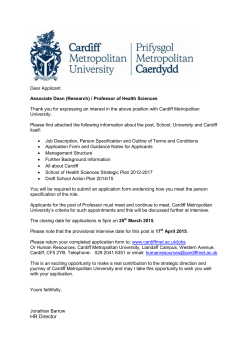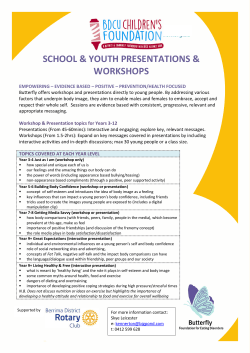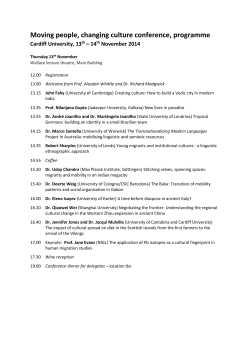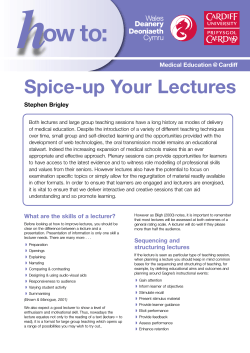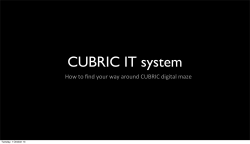
h ow to: Give an Effective Presentation
h ow to: Medical Education @ Cardiff Give an Effective Presentation Lesley Pugsley It is important to recognise that public speaking is a skill and in common with other skills, it is possible to learn how to give an effective presentation. You should use every opportunity available to you to observe the presenting styles of others and to give presentations yourself. The more practice you have and the more you observe the strategies used by others (both good and bad), the more your confidence will increase. Practice may not necessarily make perfect, but it will make giving presentations easier and will allow you to gain confidence. With practice you will find you become less nervous and more coherent. Having a critical friend sit in on a session to give you constructive feedback will also help. With a few notable exceptions there are not many natural orators. Many individuals are concerned about their ability to give an effective talk, whether it’s a presentation, a lecture or a conference paper. How we envy those gifted individuals who seem effortless in their ability to capture the attention and imaginations of their audiences. How can we ensure that we overcome nerves and deliver a message that engages and informs the audience? You may need to deliver a lecture series, ensure that students in a small group are actively engaged with a topic or enable a conference audience to appreciate the complexities and nuances of a lengthy research project in a short period of time. So how do you ensure that the presentation is effective and the experience enjoyable for the audience and the presenter? Presentations can be readily divided into two administrative stages: Q Preparation Q Delivery Preparation Planning and preparation are essential components of an effective presentation. A well planned session will help your confidence and will ensure that the audience is actively engaged with the content of your talk. Think back to presentations you have attended which you thought were poorly delivered. What was is about them that made you think this? Was there a lack of coherence, poor timekeeping, inappropriate use of visual aids, annoying mannerisms? Any one of these factors can have a significant impact on the quality of the presentation and the value of the learning experience for the audience. It can be really helpful to consider the following points when you are planning your presentations: Q What are the main points that you want to get across to the audience? Q What key take home message do you want to provide? Taking the time to think about your key messages will help focus both your choice of material and the format of the presentation. You should be aiming to help the audience to learn from your expertise, but crucially the content and tone of the presentation should be designed to meet their needs. Before you prepare the presentation you need to find out what you can about the audience. Is this a specialist or expert group? Does this group come with little or no prior knowledge of this topic? Are they your peers? Is the audience mixed in terms of knowledge and understanding? Is it a lay audience for whom technical terminology may be inappropriate? Are they being addressed in their / your first language? In order to give an effective presentation you need to be selective about both the content and the structure of your talk. To ensure that the audience gains the most from your presentation you need to consider how you will sequence the information so that it enables the participants to assimilate the new information, integrate it with any prior learning and then devise and develop schema to allow for its active retrieval. Good presentations have a logical structure; the introduction is clear and provides the audience with an overview of what is to follow, the format allows for spaced repetitions of new information and the conclusions draw the whole presentation together. Presenters may have difficulty in identifying what elements of the topic should be included or more often omitted from their presentations. A frequent problem is information overload, with presenters attempting to pack far too much new material into their talks. Identify a maximum of four key concepts that you want to consider in a one hour presentation. Sequence the information and build in a level of redundancy making use of spaced repetition and mini summaries throughout your talk. This will allow the audience the opportunity to hear the key arguments rehearsed several times and enable you to provide examples which link concepts and their applications. Think carefully about your use of visual aides. Power point, slides, overhead transparencies and flip charts can all serve to add interest and variety to the presentation. Providing your presentations are well designed and well laid out, they can be an effective way of maintaining attention and can allow you to illustrate and highlight particular points in the presentation. However it is really important not to overdo the technology. The medium should never get in the way of the message. Also remember that no equipment is foolproof! Check out the venue before hand to make sure that the audio visual equipment is all in good working order and always have a backup ready just in case the technology goes wrong. Make sure that the audio visual aides are legible from the back of the room and that the seating allows provides maximum visibility for the audience. Delivery The actual delivery of your presentation is much easier if you have practised it before hand. Rehearsing your talk against the clock is crucial. It is much better to have time left at the end to recap on your key messages and take questions from the floor, than to run out of time before you get to the most significant part of your presentation. It is particularly helpful to practice the introduction so that you feel confident that you start off well. This will enable you to look and feel more relaxed and comfortable about your ability to make the presentation. Whether you choose to stand or sit to give a presentation is a matter of personal preference. However do avoid reading your entire presentation. Should you need it, you can use your power point slides or a set of index cards as an aide memoir. You should try to focus on the audience throughout the presentation, scanning the room to check they are still engaging with what you are saying. Reading from a script prevents this level of engagement between the presenter and the group. Changing the pitch and the pace of your speech can help maintain the interest of the audience and providing summary points on power point slides or a flipchart provides you with an opportunity to rest for a moment while you allow the audience to assimilate your key messages. Crucially the key to providing an effective presentation is having a communicator who demonstrates enthusiasm for and mastery of the topic. Points to consider Q Q Q Q Q Q Q Q Does your introduction grab participant’s attention and explain your objectives? Do you follow this by clearly defining the points of the presentation? Are these main points in logical sequence? Do these flow well? Do the main points need support from visual aids? Does your closing summarise the presentation clearly and concisely? Is the conclusion strong? Have your tied the conclusion to the introduction? Further Information Chambers, R. (2000) Delivering relevant teaching well. In R. Chambers and D. Wales, Teaching made easy. Radcliffe Medical Press: Oxford. Parsell, G., Gibbs, T., and Bligh, J. (1998). Three visual techniques to enhance Interprofessonal learning. Postgraduate Medical Journal 74, 387-390. Holzl, J. (1997) Twelve tips for effective Power point presentations. Medical Teacher 19, 175-179. Lesley Pugsley is Senior Lecturer in Medical Education at the School of Postgraduate Medical and Dental Education, Cardiff University. Interested in learning more about this and other educational topics? Why not professionalise your role with an academic qualification at PGCert, Dip or MSc in Medical Education via e-learning or attendance courses. Contact: medicaleducation@cardiff.ac.uk Series Editor: Dr Lesley Pugsley, Medical Education, School of Postgraduate Medical and Dental Education, Cardiff University. Wales Deanery Cardiff University, 9th Floor, Neuadd Meirionydd, Heath Park, Cardiff CF14 4YS Tel: +44 (0)29 2068 7451 Fax: +44 (0)29 2068 7455 E-mail: medicaleducation@cardiff.ac.uk ISBN: 978-1-907019-18-0
© Copyright 2025
